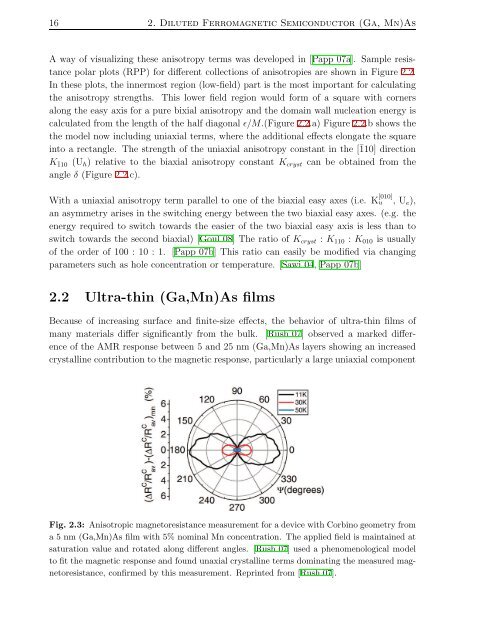As and Epitaxial-Growth MnSi Thin Films - OPUS Würzburg
As and Epitaxial-Growth MnSi Thin Films - OPUS Würzburg
As and Epitaxial-Growth MnSi Thin Films - OPUS Würzburg
Create successful ePaper yourself
Turn your PDF publications into a flip-book with our unique Google optimized e-Paper software.
16 2. Diluted Ferromagnetic Semiconductor (Ga, Mn)<strong>As</strong><br />
A way of visualizing these anisotropy terms was developed in [Papp 07a]. Sample resistance<br />
polar plots (RPP) for different collections of anisotropies are shown in Figure 2.2.<br />
In these plots, the innermost region (low-field) part is the most important for calculating<br />
the anisotropy strengths. This lower field region would form of a square with corners<br />
along the easy axis for a pure bixial anisotropy <strong>and</strong> the domain wall nucleation energy is<br />
calculated from the length of the half diagonal ǫ/M.(Figure 2.2.a) Figure 2.2.b shows the<br />
the model now including uniaxial terms, where the additional effects elongate the square<br />
into a rectangle. The strength of the uniaxial anisotropy constant in the [¯110] direction<br />
K¯110 (U h ) relative to the biaxial anisotropy constant K cryst can be obtained from the<br />
angle δ (Figure 2.2.c).<br />
With a uniaxial anisotropy term parallel to one of the biaxial easy axes (i.e. K [010]<br />
u , U e ),<br />
an asymmetry arises in the switching energy between the two biaxial easy axes. (e.g. the<br />
energy required to switch towards the easier of the two biaxial easy axis is less than to<br />
switch towards the second biaxial) [Goul 08] The ratio of K cryst : K 110 : K 010 is usually<br />
of the order of 100 : 10 : 1. [Papp 07b] This ratio can easily be modified via changing<br />
parameters such as hole concentration or temperature. [Sawi 04, Papp 07b]<br />
2.2 Ultra-thin (Ga,Mn)<strong>As</strong> films<br />
Because of increasing surface <strong>and</strong> finite-size effects, the behavior of ultra-thin films of<br />
many materials differ significantly from the bulk. [Rush 07] observed a marked difference<br />
of the AMR response between 5 <strong>and</strong> 25 nm (Ga,Mn)<strong>As</strong> layers showing an increased<br />
crystalline contribution to the magnetic response, particularly a large uniaxial component<br />
Fig. 2.3: Anisotropic magnetoresistance measurement for a device with Corbino geometry from<br />
a 5 nm (Ga,Mn)<strong>As</strong> film with 5% nominal Mn concentration. The applied field is maintained at<br />
saturation value <strong>and</strong> rotated along different angles. [Rush 07] used a phenomenological model<br />
to fit the magnetic response <strong>and</strong> found unaxial crystalline terms dominating the measured magnetoresistance,<br />
confirmed by this measurement. Reprinted from [Rush 07].
















